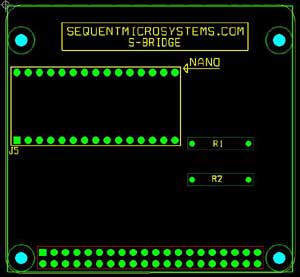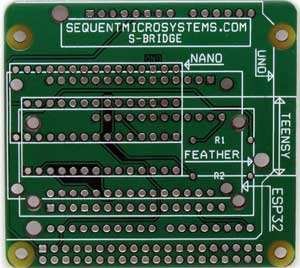FEATURES
- Arduino Uno, Nano, Teensy, Feather, or ESP32 Raspberry Pi Replacement Kit
- Mechanical dimensions identical with Raspberry Pi HAT
- Replace Raspberry Pi with Arduino UNO or NANO, TEENSY, FEATHER or ESP32
- All required hardware included for any one of the five families
- Connector soldering required
- Arduino Raspberry Pi Replacement
DESCRIPTION
Raspberry Pi Replacement Card
The Raspberry Pi Replacement card let's you use any HAT or add-on card with any of the following low cost processors: Arduino UNO or NANO, TEENSY, FEATHER or ESP32.
The Raspberry Pi Replacement card let's you use any HAT or add-on card with any of the following low cost processors: Arduino UNO or NANO, TEENSY, FEATHER or ESP32.
The Raspberry Pi Replacement card has the same form factor with Raspberry Pi and an identical 2x20 pin connector where you can plug any Raspberry Pi IO card which uses the I2C port for communication. On the opposite side, the card has male or female socket adapters where you can plug the replacement processor.
Since the card can accommodate five different families of processors, it comes unassembled. You will need to solder the 2x20 pin connecting to any Raspberry Pi add-on card, two pull-up resistors on the I2C lines, and the connectors that fit your target processor.
ASSEMBLY
In all configurations, the 2x20 pin connector is installed on top, and the processor adaptor connectors on bottom. The 2 pull-up resistors can be installed on either side. Shown here is the bottom view of an assembly of the Raspberry Pi Replacement with ARDUINO-UNO.

Replacing RASPBERRY Pi with TEENSY
Solder the R1 and R2 resistors and the 2x20 pin connector. If your TEENSY does not have the pins soldered, you can break two 14 pin sections from the 40 pin male header provided and solder the TEENSY directly on the J2 connector.
Solder the R1 and R2 resistors and the 2x20 pin connector. If your TEENSY does not have the pins soldered, you can break two 14 pin sections from the 40 pin male header provided and solder the TEENSY directly on the J2 connector.
If the TEENSY has the pins soldered, break 2 pins from each of the 16 pin female headers provided, and solder the female headers into the J2 connector as shown. Plug the TEENSY into J2 connector.

Replacing RASPBERRY Pi with UNO
Solder the R1 and R2 resistors and the 2x20 pin connector. Break the 40 pin male header provided into 6, 2 x 8, and 10 pins. Solder the breakout pins on the footprint of connector J4 as shown. Plug the UNO into the J4 connectors and secure with standoffs (not provided), if necessary.

Replacing RASPBERRY Pi with ESP32
Solder the R1 and R2 resistors and the 2x20 pin connector. If your ESP32 does not have the pins soldered, you can break two 15 pin sections from the 40 pin male header provided and solder the FEATHER directly on the J3 connector.
Solder the R1 and R2 resistors and the 2x20 pin connector. If your ESP32 does not have the pins soldered, you can break two 15 pin sections from the 40 pin male header provided and solder the FEATHER directly on the J3 connector.
If the FEATHER has the pins soldered, break 1 pin from each of the 16 pin female headers provided, and solder the female headers into the J6 connector as shown. Secure the ESP32 processor with stand-offs (not provided) if necessary.

Replacing RASPBERRY Pi with FEATHER
Solder the R1 and R2 resistors and the 2x20 pin connector. If your FEATHER does not have the pins soldered, you can break a 12 pin and a 16 pin sections from the 40 pin male header provided and solder the FEATHER directly on the J3 connector.
Solder the R1 and R2 resistors and the 2x20 pin connector. If your FEATHER does not have the pins soldered, you can break a 12 pin and a 16 pin sections from the 40 pin male header provided and solder the FEATHER directly on the J3 connector.
If the FEATHER has the pins soldered, break 4 pins from one of the 16 pin female headers provided, and solder the female headers into the J3 connector as shown. Plug the FEATHER into the J3 connector and secure with extra stand-offs (not provided) if necessary.

Replacing RASPBERRY Pi with NANO
Solder the R1 and R2 resistors and the 2x20 pin connector. Cut or pull one end pin of the two 16 pin female headers provided. Solder the female headers on the footprint of connector J5 as shown bellow. Plug the NANO into the J5 connectors.
Solder the R1 and R2 resistors and the 2x20 pin connector. Cut or pull one end pin of the two 16 pin female headers provided. Solder the female headers on the footprint of connector J5 as shown bellow. Plug the NANO into the J5 connectors.

DOWNLOADS
2D CAD drawing
SOFTWARE
You can write your own application using 8-Relays and 8-Mosfets Arduino Libraries. More libraries will be available soon.
The libraries works only with TEENSY 3.2/3.5/3.6/4.0/4.1, Arduino UNO, Arduino NANO, Adafruit FEATHER, ESP32 DEVKIT V1. The main reason for this is the electrical and mechanical constraints of the S-BRIDGE card. If your favorite processor is not on the list, you also can use it if it has an I2C port, but you need to connect the I2C port directly to the card.
YOUR KIT
When you purchase the Raspberry Pi Replacement Kit you will receive the following items:
1. Bare PCB adapter board

2. 2X20 Male Pin Header

3. Two 2x16 Female Headers

3. One 1x40 breakable male pin header

4. Two 2.2K I2C pull-up resistors

APPLICATION
The following show one of the easiest and cheapest ways to control AC or DC loads from the Internet. Using the Raspberry Pi replacement card, the ESP32 processor and the 8-RELAY Card, this setup lets you control up to 8 loads of 120V and 8A each from your browser.













